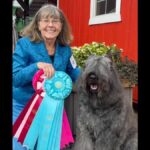Breeding purebred dogs is more than preservation. Featured photo by Ann Schiavone.
The Truth About Breeding Dogs (It’s More Than Preservation!)
One of the first dog books I ever bought remains one of my favorites. I purchased The Truth About Sporting Dogs by C. Bede Maxwell shortly after I’d attended my first dog show, and I periodically refer to my copy as a reference for pointers, setters, spaniels, and retrievers. Published in 1972 by Howell Book House Inc., this 336-page masterwork is generously sprinkled with photographs of the gundog breeds that were recognized by AKC at the time. (The photo of a Curly-Coated Retriever battling a water-bound kangaroo never fails to astonish.) As the book’s publisher, Elsworth S. Howell, notes in the foreword, “You will read material and see pictures that probably never before have been placed in the light of public view on such a scale.” From his remark, it’s clear that Mr. Howell hadn’t anticipated the coming of the Internet.
As fascinating as the book’s many images may be (and they are indeed fascinating), it’s the volume’s confident title that has always intrigued me. By introducing her well-researched compendium as “the truth,” Mrs. Maxwell confidently presents breed-specific material as fact, painstakingly researched and reliably vetted. Even today, more than 50 years on, the lady’s contribution to the bibliography of Sporting Dogs delivers on both accuracy and authenticity. Her collection of breed vignettes doesn’t rely on conjecture, theory or opinion. Instead, Mrs. Maxwell’s findings are presented in a voice that proclaims, “This is the truth as I understand it.”
To borrow from the spirit of Mrs. Maxwell’s book, the truth about breeding dogs is that breeders are many things to many people. Breeders are preservationists, certainly, but this is not their only role. Breeders are conservationists too, and they are scientists and artists. Breeders are also anthropologists who devote themselves to the people who offer their puppies a home. Breeding dogs requires every breeder to be everything to everyone. Breeding dogs is a challenge—and it’s rewarding—and that’s the truth.
Breeders are preservationists, certainly, but this is not their only role.
THE BREEDER AS PRESERVATIONIST
For more than two decades now, purebred dog breeders have taken up the “preservation breeder” mantle. This is really something of a formality, since breeding purebred dogs has always been about preserving a sire and dam’s DNA through their progeny. However, the selections made by today’s self-described preservation breeders are prompted by a very real sense of urgency. Today’s experienced purebred dog breeders are aging and/or retiring from the whelping box, and in many breeds they are not being replaced by newcomers. The reasons for this dilemma are many, from anti-purebred sentiment and local breeding restrictions to the financial investment required to health test breeding stock and raise a healthy litter. And with more than half of all AKC-recognized breeds currently classified by the registry as “low entry,” the preservation designation has become an edict for those who recognize that every breed, just like every breeder’s “line” within a breed, is vulnerable to extinction.
THE BREEDER AS CONSERVATIONIST
One of the things that draws people to the Sporting breeds is a genuine appreciation for the natural world. Spending time sitting with a bird dog in a boat or blind, or walking together through a woodland or riding across a field on horseback, is a shared experience that encourages a connection to the environment as it reinforces the human-canine bond. With time, most sporting men and women are likely to become stewards of the environment. Hunters, in particular, can develop a deep understanding of biodiversity and the interdependence of all living things. The dogs that accompany them on prairies and in ponds help to ensure access to wide-open spaces for future generations to enjoy. These outdoor places provide educational experiences for hikers and cyclists too, and they offer resident and migratory birds a place to rest—and nest. By supplying gunners with Sporting Dogs (and Hounds and Terriers), breeders are contributing to conservation efforts that capably manage and protect the environment.
THE BREEDER AS SCIENTIST
The science of dog breeding has largely been the domain of the veterinarian. In the 1760s, the first school of veterinary medicine was established in Lyon, France, and a century later, the American Veterinary Medical Association was founded in 1863. This organization’s genesis coincides with the advent of purebred dog exhibitions, so the symbiotic relationship between hobby breeders and professional veterinarians has existed from the start. In recent decades, however, advancements in technology and diagnostics have brought veterinary medicine out of the office and onto the Internet where breeders are able to determine inbreeding coefficients, search online canine health databases, research options for treating diseases, and even consider alternative ways to improve overall canine health and wellness. The availability of information certainly benefits breeders today, but the science doesn’t come without risk. For although today’s breeders have access to more information than ever before, tomorrow’s breeders could find themselves without their forebears’ home remedies and “old-school” knowledge.
THE BREEDER AS ARTIST
Dog shows have long been criticized by some as mere beauty pageants, vain and vapid parades where dogs prance and pose alongside men and women dressed for a business meeting or a
holiday office party à la Mad Men. This assessment is usually offered by casual viewers of televised shows like Westminster who see the dogs and the outfits without knowing much about the people wearing the clothes and holding the leads. Even less is known about the people who breed the beautiful dogs on display, the master breeders who’ve created those extraordinary canines much as Pablo Picasso painted and Martha Graham danced. And just as Picasso’s paintings and Graham’s performances are not appreciated by all, the purebred dog breeders’ efforts are undertaken not for acclaim but for the sake of art itself. As artists, breeders and painters and dancers do what they do as a form of expression. Talent, knowledge, and skill are applied in an everlasting quest to tap into a part of the human spirit that’s impossible to define—but once experienced, cannot be forgotten. Those show dogs on TV are the life’s work of genuine artists.
THE BREEDER AS ANTHROPOLOGIST
For all the talk about breeding to preserve and conserve, and breeding as science and art, the truth about breeding dogs is that it’s really all about people. Everything a breeder does, from the selection of stock to the socialization of puppies and their placement in homes near and far, involves important exchanges with other people. Breeders interact with stud dog owners and potential puppy buyers in ways that need to support successful outcomes for everyone. Breeders need to consider everybody’s goals, not just their own. This means lots of email exchanges and late-night phone calls and text messages when all the feeding and training and grooming and cleaning are done. Years of communicating with others affords experienced breeders a keen understanding of human nature as it relates to their breed. Longtime breeders who’ve raised many generations learn to “read” human behavior just as they recognize the meaning of each puppies’ actions and reactions. And, like serious anthropologists, breeders learn to listen and observe in order to determine if someone else’s lifestyle is suitable for their particular breed—or not.
Purebred dog breeders might choose to argue whether the truth about breeding dogs is relative to the individual breeder or if there are universal truths that apply to all breeders. That argument is really for philosophers to consider. In the meantime, today’s breeders would do well to emulate Mrs. Maxwell’s example by approaching dog breeding as a serious study that results in a life’s work that’s generously shared for the benefit of others.










